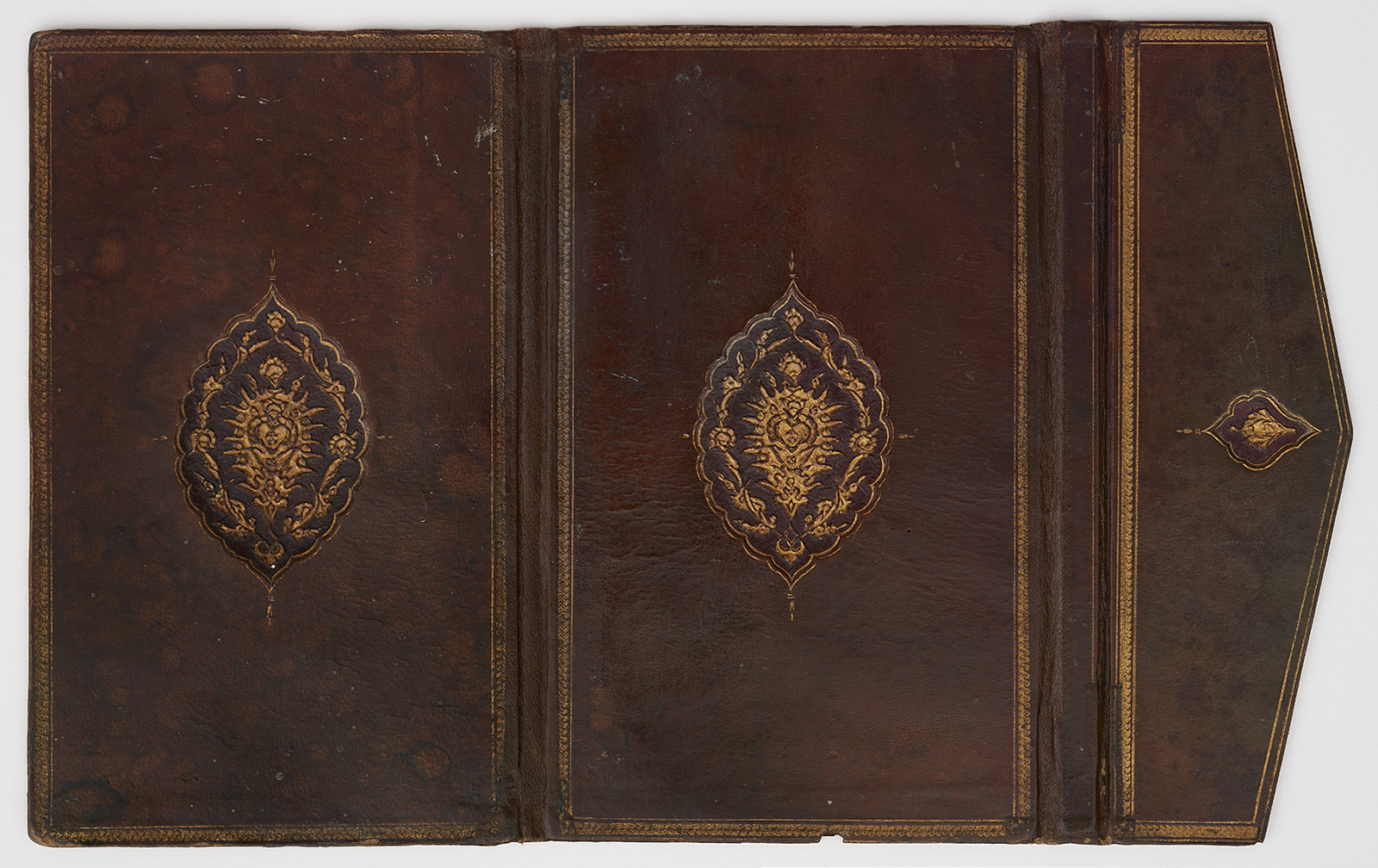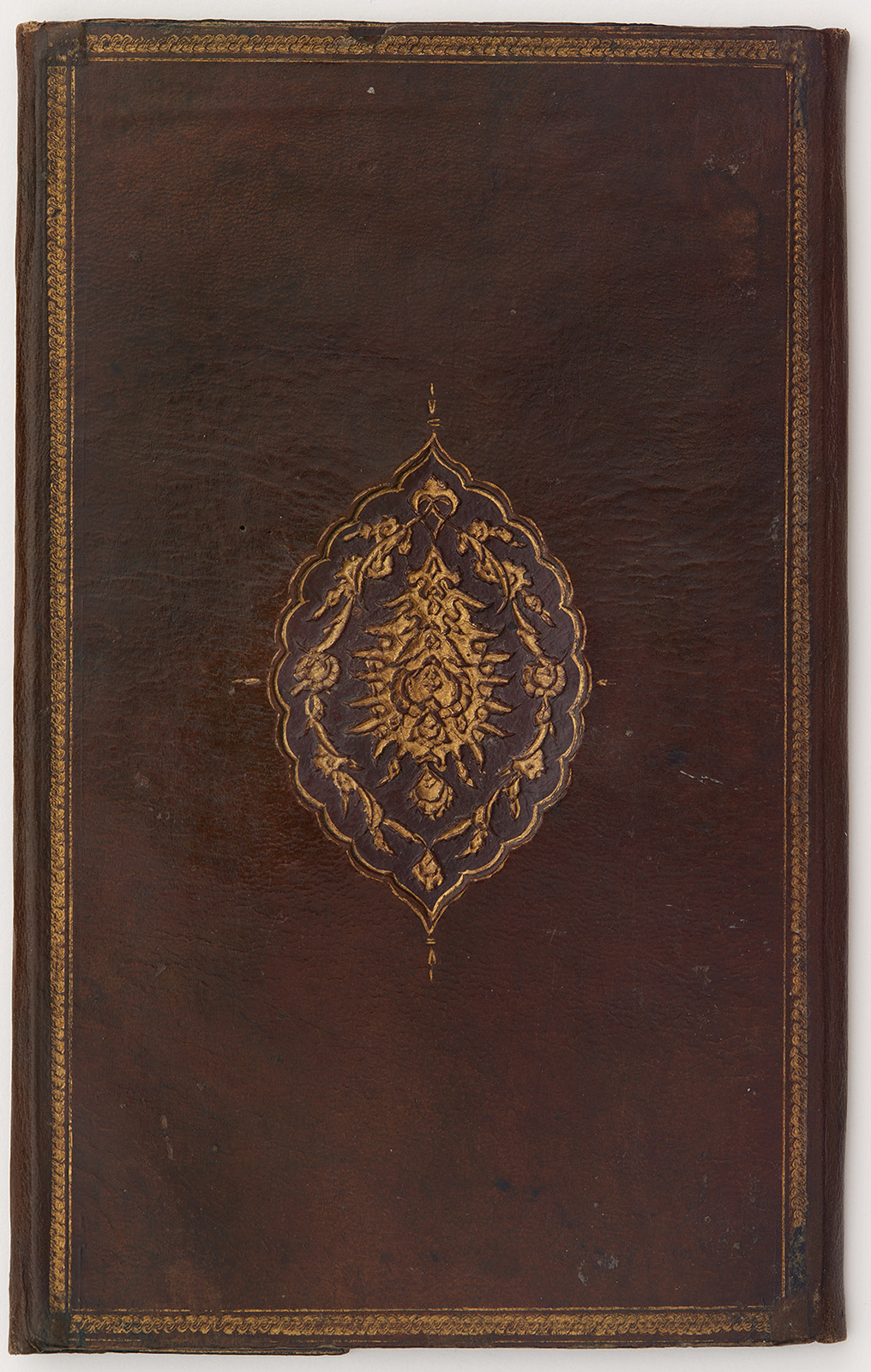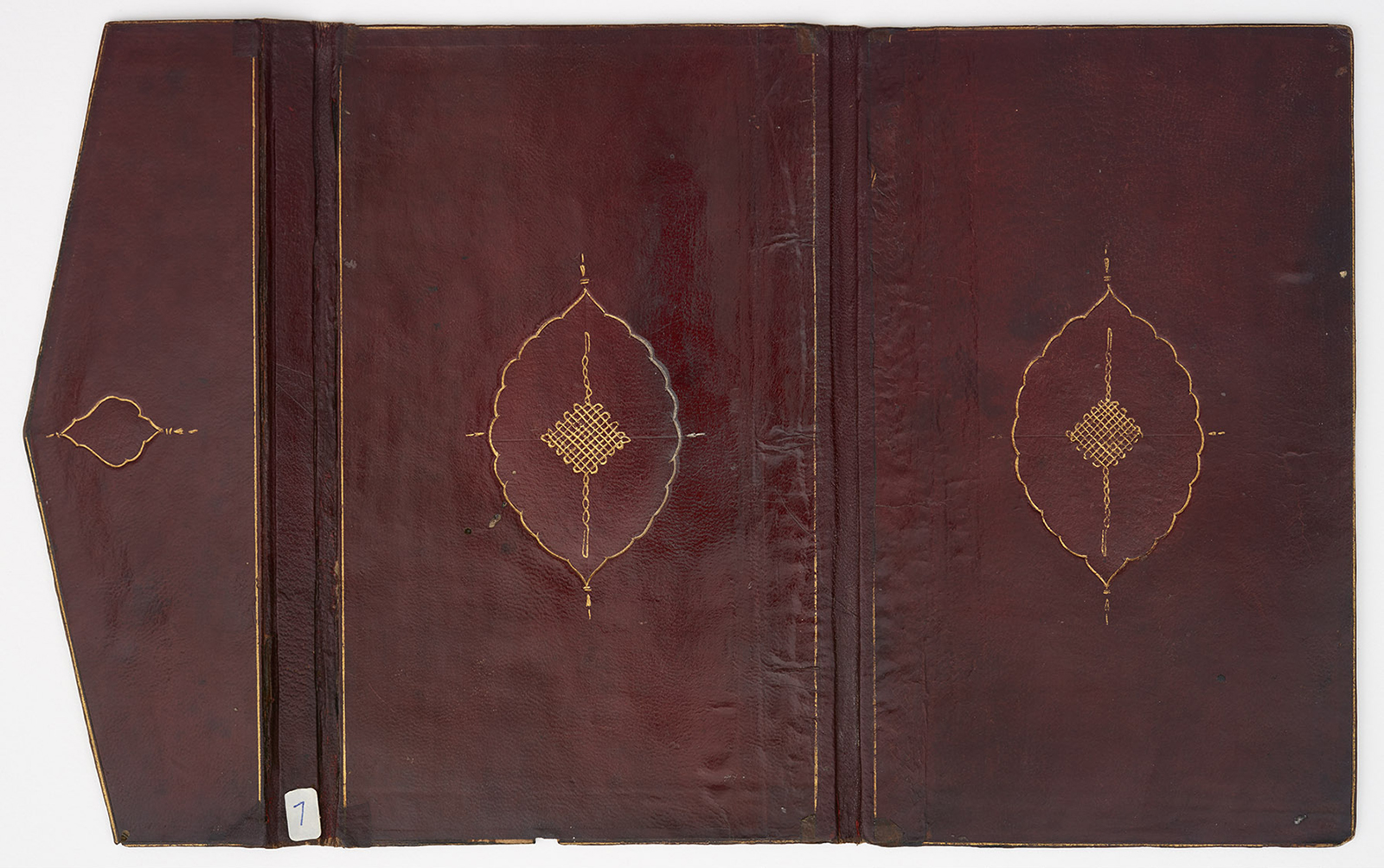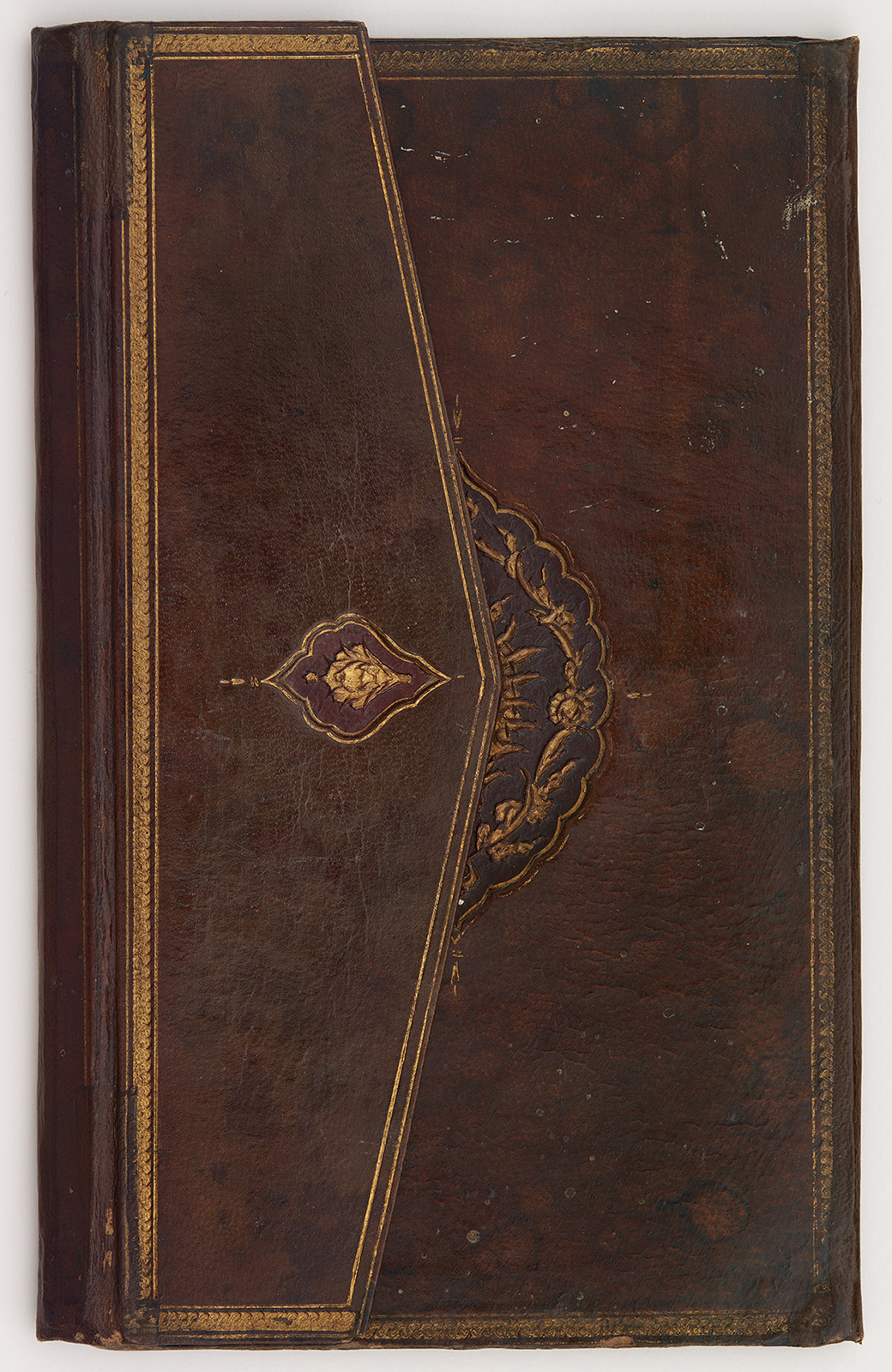Click on the image to zoom
Binding, outer covers and doublures: upper, lower, and flap
- Accession Number:AKM394
- Place:Turkey
- Dimensions:20.4 cm × 12.4 cm
- Date:possibly 17th century
- Materials and Technique:Leather, pasteboard, gold
The earliest surviving royal style Ottoman Turkish bindings were produced in Bursa and Edirne around 1430. For centuries, the decorative composition on the covers and doublures of Turkish bindings decoration remained essentially unchanged, consisting of a medallion with pendants and cornerpieces at each corner of the central field. After 1460, the nakkaşhane or court art studio began to develop at Topkapı Palace in Istanbul, resulting in an increase in the production of fine books bound by master binders. These bindings with medallion and cornerpiece compositions were often beautifully decorated with tooled and stamped designs on leather. At other times, craftsmen faced the covers in Italian or Bursa velvet, or Ottoman, Mamluk, or Chinese brocaded silk fabric.[1]
Further Reading
Beginning in the 16th century, the materials used to face the bindings of royal books and the decorative techniques became more diverse, and included jewel-studded gold and silver plaques, embroidered silk fabric, and embroidered leather. Lacquer decoration with figures and flower motifs was used on both the covers and doublures of leather bindings.[2]
The most common type of binding decoration after 1500 was a central oval medallion and cornerpieces. These were recessed and filled with stamped decoration in high relief, consisting of broad curving and sometimes broken stems bearing large stylized composite flowers, composite buds arrayed from small to large, and large lanceolate leaves. In some cases, a second tier of cloud motifs overlaid this lower level of decoration. The broad border was also recessed and filled with similar high relief stamped lanceolate leaves and stylized composite flowers. A recessed medallion often adorned the flap.
On royal bindings of this type, huge stylized composite flowers like cartouches commonly filled the border. The medallion, cornerpieces, and borders were either entirely gilded or featured only a gilded ground, leaving the motifs in the natural colour of the leather. From archival documents we learn that this style was the invention of the binder Mehmed Çelebi. Since the stamps made of leather or metal that he used for the medallions, cornerpieces, and border decoration on his bindings from 1525–30 onwards were later passed from hand to hand, his designs lived on for many years. Bindings in this style became known as the “Mehmed Çelebi style.”[3] Even when renewing the worn bindings of early books, the new bindings were made in his style.
Binders who followed in the footsteps of Mehmed Çelebi elaborated on his design by adding borders, cartouches, and inscriptions to create beautiful, elegant, and monumental bindings.[4] Even today modern binders who continue to create traditional Turkish bindings still follow the style of Mehmed Çelebi.[5] In no other country where Islamic bindings are produced has the decorative style of any binder proved so lasting.
On these outer covers in the Aga Khan Museum Collection, a large oval medallion of dark chestnut-coloured leather has been centrally placed. A small pyriform medallion of light chestnut-coloured leather containing a stylized composite flower occupies the centre of the flap. The large medallions are filled with a large stylized leaf (possibly from a tropical tree) combined with a large stylized composite flower. This motif is encircled by a curving branch bearing lanceolate leaves and small stylized composite flowers. The composition shines like a gold brooch at the centre of the cover. The motifs of this stamped design in high relief have been gilded, but their contours left ungilded. The composition of the central medallion derives from the binder Mehmed Çelebi, who often placed it in the broad border of his bindings.[6] In the 17th and 18th centuries this motif was used alone on the front and back covers and flap.[7]
The light chestnut-coloured doublures of AKM394 also have an oval medallion drawn in gold at its centre. Inside this medallion, a rosette is formed by interlacing bands.
- Tanındı, Zeren
Notes
1. See Julian Raby and Zeren Tanındı, Turkish Book Binding in the 15th Century. The Foundation of an Ottoman Court Style.
2. Zeren Tanındı, “Books and Bindings,” 840–63.
3. Ibid., “Rugani Türk Kitap Kaplarının Erken Örnekleri,” 223–53, 241, 243; JM Rogers, Empire of the Sultans. Ottoman Art From the Collection of Nasser D. Khalili, 220; Esin Atıl, Süleymanname: The Illustrated History of Süleyman the Magnificent, 81; Tanındı, “Books and Bindings,” 847, 849–50.
4. Followers of Mehmed Çelebi and his family who flourished in the late 16th century and early 17th century are the binders Kara Mehmed, Süleyman, and Abdi b. Şaban. See Museum für Kunsthandwerk, Turkische Kunst und Kultur aus osmanischer Zeit. Ausstellungskatalog, 106, cat. 1/87; Massumeh Farhad and Simon Rettig, eds. The Art of the Qur’an. Treasures from the Museum of Turkish and Islamic Arts, 15 October 2016–20 February 2017, 340–41, cat. 62. For late examples, see Kemal Çığ, Türk Kitap Kapları, 48; and Mine E. Özen, Türk Cilt Sanatı, 61.
5. Uğur Derman, Doksandokuz İstanbul Mushafı, 373; Ahmet Akçan, ed., International Book Binding Meeting, İstanbul 28 November–14 December 2014. Symposium Papers and Exhibitions Catalogue, vols. I-II.
6. Zeren Tanındı, “Books and Bindings,” 847.
7. Yıldıray Özbek, Kayseri Raşid Efendi Kütüphanesindeki Kitap Kapakları, 72, 99. For an outstanding example of this decorative composition, see Basil W. Robinson et al., “Book-Covers and Lacquer,” 307, cat. VIII-41-43, pl. 156.
References
Akçan, Ahmet, ed. Uluslararası Cilt Sanatı Buluşması. İstanbul, 28 Kasım–8 Aralık 2014. Sempozyum Bildirileri ve Sergilerin Kataloğu, c.I-II. İstanbul: Istanbul Büyüksehir Belediyesi, 2014. (International Book Binding Meeting, İstanbul 28 November–14 December 2014. Symposium Papers and Exhibitions Catalogue, vols. I-II. İstanbul: Istanbul Büyüksehir Belediyesi, 2014.) ISBN: 9786058523500
Atıl, Esin. Süleymanname: The Illustrated History of Süleyman the Magnificent. Washington, DC and New York: National Gallery of Art/Harry N. Abrams, 1986. ISBN: 9780894680885
Çığ, Kemal. Türk Kitap Kapları. Ankara: Yapi ve Kredi Bankasi, 1971
Derman, Uğur. Doksandokuz İstanbul Mushafı. İstanbul: Avrupa Kültür Başkenti, 2010. ISBN: 9786058815322
Farhad, Massumeh and Simon Rettig, eds. The Art of the Qur’an. Treasures from the Museum of Turkish and Islamic Arts, 15 October 2016–20 February 2017. Washington, DC: The Freer Gallery of Art, Arthur M. Sackler Gallery, Smithsonian Institution, 2016. ISBN: 9781588345783
Museum für Kunsthandwerk. Turkische Kunst und Kultur aus osmanischer Zeit. Ausstellungskatalog. Frankfurt: Aurel Bongers, 1985. ISBN: 9783764703691
Özbek, Yıldıray. Kayseri Raşid Efendi Kütüphanesindeki Kitap Kapakları. Kayseri: Erciyes Üniversitesi, 2005. ISBN: 9789756667026
Özen, Mine E. Türk Cilt Sanatı. Ankara: Türkiye İş Bankası Kültür Yayınları, 1998. ISBN: 9789754581287
Raby, Julian and Zeren Tanındı. Turkish Book Binding in the 15th Century. The Foundation of an Ottoman Court Style. London: Azimuth editions on behalf of l'Association Internationale de Bibliophilie, 1993. ISBN: 9781898592013
Robinson, Basil W. et al. “Book-Covers and Lacquer.” The Keir Collection. Islamic Painting and the Arts of the Book. London: Faber and Faber, 1976. ISBN: 9780571108664
Rogers, JM. Empire of the Sultans. Ottoman Art From the Collection of Nasser D. Khalili. London: Arts Services International, Alexandria, Virginia, & The Nour Foundation, London, in association with the Khalili Family Trust, 1995. ISBN: 9782830601206
Tanındı, Zeren. “Rugani Türk Kitap Kaplarının Erken Örnekleri." Kemal Çığ'a Armağan. İstanbul: Topkapı Müzesi Müdürlüğü Yayınları, 1984, 223–53
“Books and Bindings,” Ottoman Civilization, eds. H. İnalcık and G. Renda. Ankara: Milli Kütüphane Yayınları, 2003, 840–63. ISBN: 9789751730725
Note: This online resource is reviewed and updated on an ongoing basis. We are committed to improving this information and will revise and update knowledge about this object as it becomes available.








